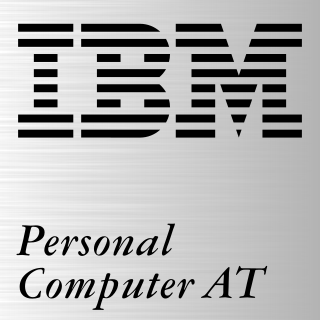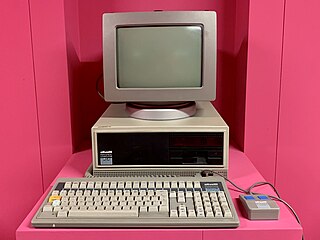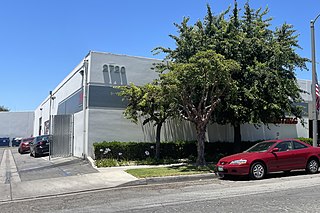
The Tandy 1000 is the first in a line of IBM PC compatible home computer systems produced by the Tandy Corporation for sale in its Radio Shack and Radio Shack Computer Center chains of stores. Introduced in 1984, the product line was aimed at providing affordable but capable systems for home computing or education, with some of its Tandy specific features like graphics, sound and joystick port making it more appealing for home use.

The Personal System/2 or PS/2 is IBM's second generation of personal computers. Released in 1987, it officially replaced the IBM PC, XT, AT, and PC Convertible in IBM's lineup. Many of the PS/2's innovations, such as the 16550 UART, 1440 KB 3.5-inch floppy disk format, 72-pin SIMMs, the PS/2 port, and the VGA video standard, went on to become standards in the broader PC market.

The IBM Personal Computer AT was released in 1984 as the fourth model in the IBM Personal Computer line, following the IBM PC/XT and its IBM Portable PC variant. It was designed around the Intel 80286 microprocessor.

The Tandy 2000 is a personal computer introduced by Radio Shack in September 1983 based on the 8 MHz Intel 80186 microprocessor running MS-DOS. By comparison, the IBM PC XT used the older 4.77 MHz Intel 8088 processor, and the IBM PC/AT would later use the newer 6 MHz Intel 80286. Due to the 16-bit data bus and more efficient instruction decoding of the 80186, the Tandy 2000 ran significantly faster than other PC compatibles, and slightly faster than the PC AT. The Tandy 2000 was the company's first computer built around an Intel x86 series microprocessor; previous models used the Zilog Z80 and Motorola 6809 CPUs.

The Amstrad PC1512 was Amstrad's mostly IBM PC-compatible computer system, launched in 1986, and advertised with prices from £399 plus VAT. The system was also marketed in the US by Texas-based Vidco Inc. from the start of 1987. Later in 1987, a slightly updated version called the PC1640 was introduced, also marketed as the PC6400 and Sinclair PC500. Schneider branded machines for the German market were also sold.

Compaq's first computers' form factors were portable, also called "luggables", and then "lunchbox computers", and together constituted the Compaq Portable series. These computers measured approximately 16 inches (410 mm) deep, 8 inches (200 mm) tall, and approximately 20 inches (510 mm) wide. As the products evolved, laptops and notebooks were created offing a new level of portability that caused the market to explode.

The Leading Edge Model D is an IBM clone first released by Leading Edge Hardware in July 1985. It was initially priced at $1,495 and configured with dual 5.25" floppy drives, 256 KB of RAM, and a monochrome monitor. It was manufactured by South Korean conglomerate Daewoo and distributed by Canton, Massachusetts-based Leading Edge. Engineer Stephen Kahng spent about four months designing the Model D at a cost of $200,000. Kahng later became CEO of Macintosh clone maker Power Computing.

The Epson Equity series of IBM Compatible Personal Computers was manufactured from 1985 until the early '90s by Epson Inc. Epson was well known for its dot matrix printers at the time and the Equity series represents their entry into the growing PC compatible market. The Equity I was the first system introduced, equipped with an Intel 8088 CPU and one or two 5.25" floppy disk drives.
The Commodore PC compatible systems are a range of IBM PC compatible personal computers introduced in 1984 by home computer manufacturer Commodore Business Machines.

The Olivetti M24 is a computer that was sold by Olivetti in 1983 using the Intel 8086 CPU.

The Deskpro 386 is a line of desktop computers in Compaq's Deskpro range of IBM PC compatibles. Introduced in September 1986, the Deskpro 386 was the first personal computer to feature Intel's 32-bit 80386 microprocessor. It also marks the first time that a major component of the IBM Personal Computer de facto standard was updated by a company other than IBM themselves—in this case, upgrading from the 80286 processor of the Personal Computer/AT.
The Tandy 3000 is a personal computer introduced by Radio Shack in 1986 based on the 16-bit 8 MHz Intel 80286 microprocessor.

Blue Chip Electronics, Inc., later Blue Chip International, was an American computer company founded by John Rossi in 1982. Founded to develop peripherals for Commodore home computers, the company in 1986 began selling low-cost IBM PC compatibles.

American Computer & Peripheral, Inc. (AC&P), also written as American Computer and Peripheral, was an American computer company based in Santa Ana, California. The company was founded in 1985 by Alan Lau and released several expansion boards for the IBM PC as well as a few PC clones before going bankrupt in December 1989. Obscure in its own time, the company's 386 Translator was the first plug-in board for Intel's newly released 80386 processor and the first mass-market computing device to offer consumers a means of using the 386 in July 1986.

The Personal System/2 Model 25 and its later submodels the 25 286 and 25 SX are IBM's lowest-end entries in the Personal System/2 (PS/2) family of personal computers. Like its sibling the Model 30, the Model 25 features an Industry Standard Architecture bus, allowing it to use expansion cards from its direct predecessors, the PC/XT and the PC/AT—but not from higher entries in the PS/2 line, which use Micro Channel. Unlike all other entries in the PS/2 line, the Model 25 and its submodels are built into an all-in-one form factor, with its cathode-ray tube (CRT) monitor and system board occupying the same enclosure. IBM oriented the Model 25 at home office workers and students.

The Personal System/2 Model 50 is a midrange desktop computer in IBM's Personal System/2 (PS/2) family of personal computers. First released in April 1987, the Model 50 features an Intel 80286 processor running at a clock speed of 10 MHz. In June 1988, the PS/2 Model 50 received an update in the form of the Personal System/2 Model 50 Z, which offered faster RAM, eliminating the insertion of wait states endemic to the original Model 50 and increasing system performance. The Model 50 was the best-selling line of PS/2 for several years, IBM selling over 440,000 units in the first year of its availability.

The Personal System/2 Model 60 is a high-end desktop computer in IBM's Personal System/2 (PS/2) family of personal computers. First released in April 1987, the Model 60 features an Intel 80286 processor running at a clock speed of 10 MHz, the same as its midrange counterpart, the Personal System/2 Model 50. Unlike the Model 50, the Model 60 was built into a tower case and featured four more 16-bit MCA expansion slots and an additional drive bay. The Model 60 was IBM's first Intel-based PC built into a tower form factor and was influential in popularizing towers in computer case design.

The SupersPort is a line of PC-compatible laptops manufactured by Zenith Data Systems and sold from 1988 to 1993. The first two main entries in the SupersPort line included either an Intel 80286 microprocessor clocked at 12 MHz or an 8088 processor clocked at 8 or 4.77 MHz, switchable. Later entries included the 386SX, 486SX and 486 processors. The SupersPort 286 in particular was one of the top-selling laptops of the late 1980s, although Zenith's position in this segment faltered by the early 1990s.

Cumulus Corporation was an American computer peripheral and system manufacturer active from 1987 to 1993. Based in Beachwood, Ohio and started by Tecmar founder Martin Alpert, the company set out to exclusively manufacture expansion products for IBM's Personal System/2 (PS/2) family of computers—mainly RAM expansion cards. It later released cross-platform CPU upgrade cards and memory expansion cards for other platforms besides the PS/2. Beginning in 1990, the company began trading as Cumulus Computer Corporation and began releasing complete systems of their own. Initially a success story for the tech industry in Cleveland, a botched stock launch in 1992 proved disastrous for the company's ailing cash flow situation, and in 1993 the company was liquidated amid massive debt to suppliers and lenders.






















